University Leadership Report: Dynamics of Leadership Analysis
VerifiedAdded on 2023/04/21
|43
|10836
|407
Report
AI Summary
This report, prepared for a Human Resources department, analyzes the dynamics of leadership within an organization. It differentiates between managers and leaders, exploring leader development through education and experience, and evaluating methods to measure leadership success. The report also examines different types of followership, the relationship between leaders, followers, and the environment, and critically analyzes the contributions of leaders. Furthermore, it delves into the concept of values, organizational culture, personality, and intelligence in leadership, and contrasts power and influence. The report also covers team dynamics, including the stages of team development, leadership within groups and teams, and strategies for leading virtual teams, with an assessment of motivational and satisfaction factors. Finally, the report analyzes how task interdependence, organizational factors, and environmental influences affect leadership, as well as rational and emotional approaches to organizational change. The report utilizes academic theories and real-world examples to support its analysis.
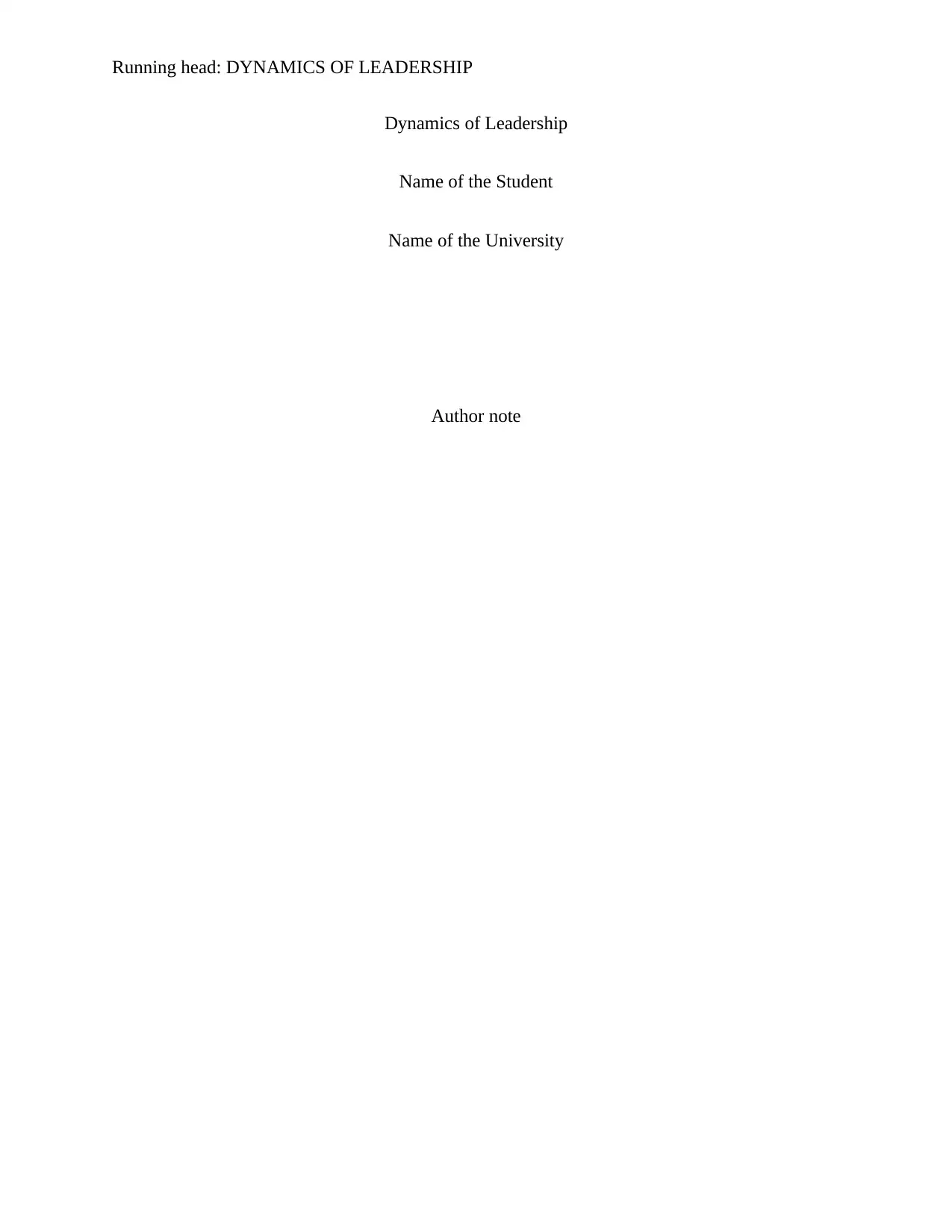
Running head: DYNAMICS OF LEADERSHIP
Dynamics of Leadership
Name of the Student
Name of the University
Author note
Dynamics of Leadership
Name of the Student
Name of the University
Author note
Paraphrase This Document
Need a fresh take? Get an instant paraphrase of this document with our AI Paraphraser
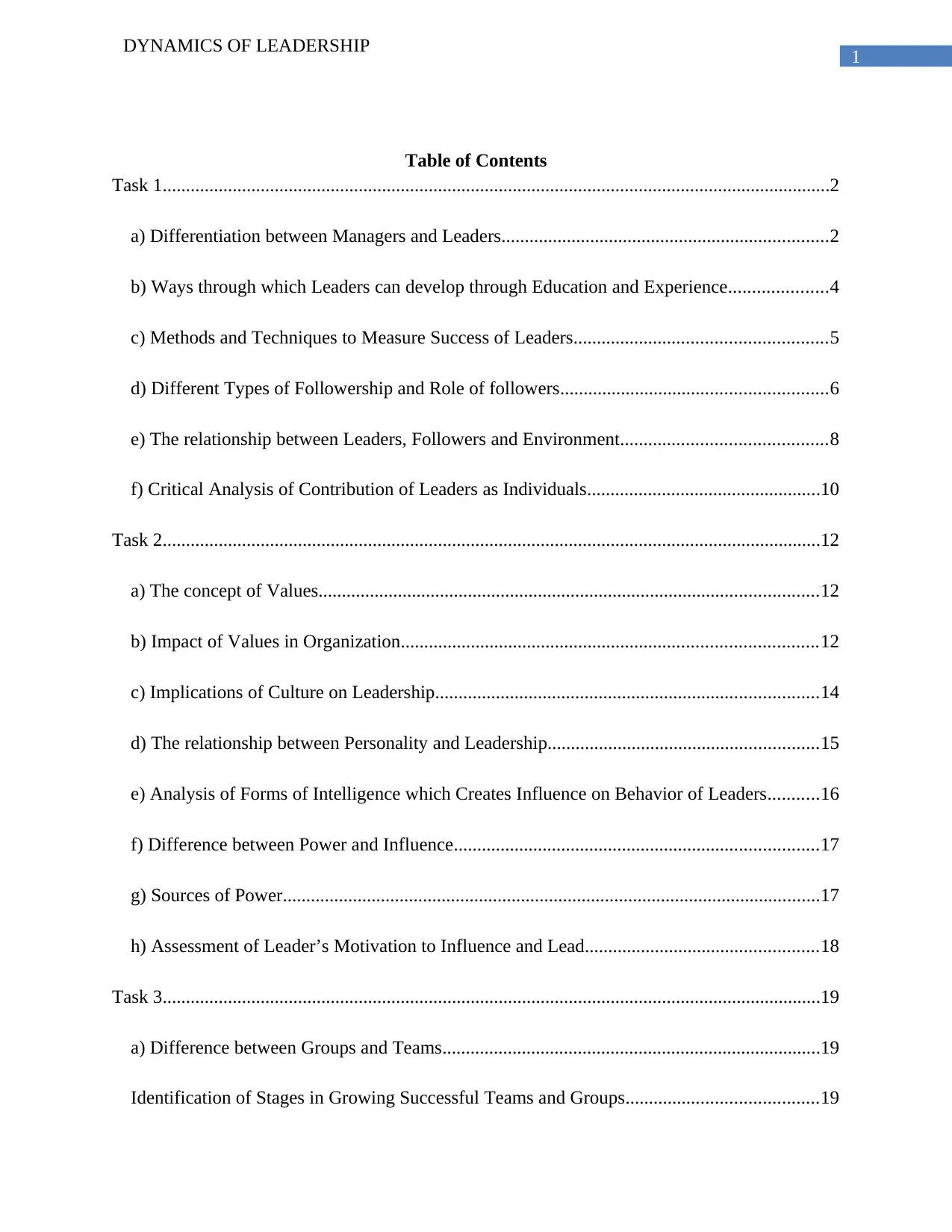
1
DYNAMICS OF LEADERSHIP
Table of Contents
Task 1...............................................................................................................................................2
a) Differentiation between Managers and Leaders......................................................................2
b) Ways through which Leaders can develop through Education and Experience.....................4
c) Methods and Techniques to Measure Success of Leaders......................................................5
d) Different Types of Followership and Role of followers.........................................................6
e) The relationship between Leaders, Followers and Environment............................................8
f) Critical Analysis of Contribution of Leaders as Individuals..................................................10
Task 2.............................................................................................................................................12
a) The concept of Values...........................................................................................................12
b) Impact of Values in Organization.........................................................................................12
c) Implications of Culture on Leadership..................................................................................14
d) The relationship between Personality and Leadership..........................................................15
e) Analysis of Forms of Intelligence which Creates Influence on Behavior of Leaders...........16
f) Difference between Power and Influence..............................................................................17
g) Sources of Power...................................................................................................................17
h) Assessment of Leader’s Motivation to Influence and Lead..................................................18
Task 3.............................................................................................................................................19
a) Difference between Groups and Teams.................................................................................19
Identification of Stages in Growing Successful Teams and Groups.........................................19
DYNAMICS OF LEADERSHIP
Table of Contents
Task 1...............................................................................................................................................2
a) Differentiation between Managers and Leaders......................................................................2
b) Ways through which Leaders can develop through Education and Experience.....................4
c) Methods and Techniques to Measure Success of Leaders......................................................5
d) Different Types of Followership and Role of followers.........................................................6
e) The relationship between Leaders, Followers and Environment............................................8
f) Critical Analysis of Contribution of Leaders as Individuals..................................................10
Task 2.............................................................................................................................................12
a) The concept of Values...........................................................................................................12
b) Impact of Values in Organization.........................................................................................12
c) Implications of Culture on Leadership..................................................................................14
d) The relationship between Personality and Leadership..........................................................15
e) Analysis of Forms of Intelligence which Creates Influence on Behavior of Leaders...........16
f) Difference between Power and Influence..............................................................................17
g) Sources of Power...................................................................................................................17
h) Assessment of Leader’s Motivation to Influence and Lead..................................................18
Task 3.............................................................................................................................................19
a) Difference between Groups and Teams.................................................................................19
Identification of Stages in Growing Successful Teams and Groups.........................................19
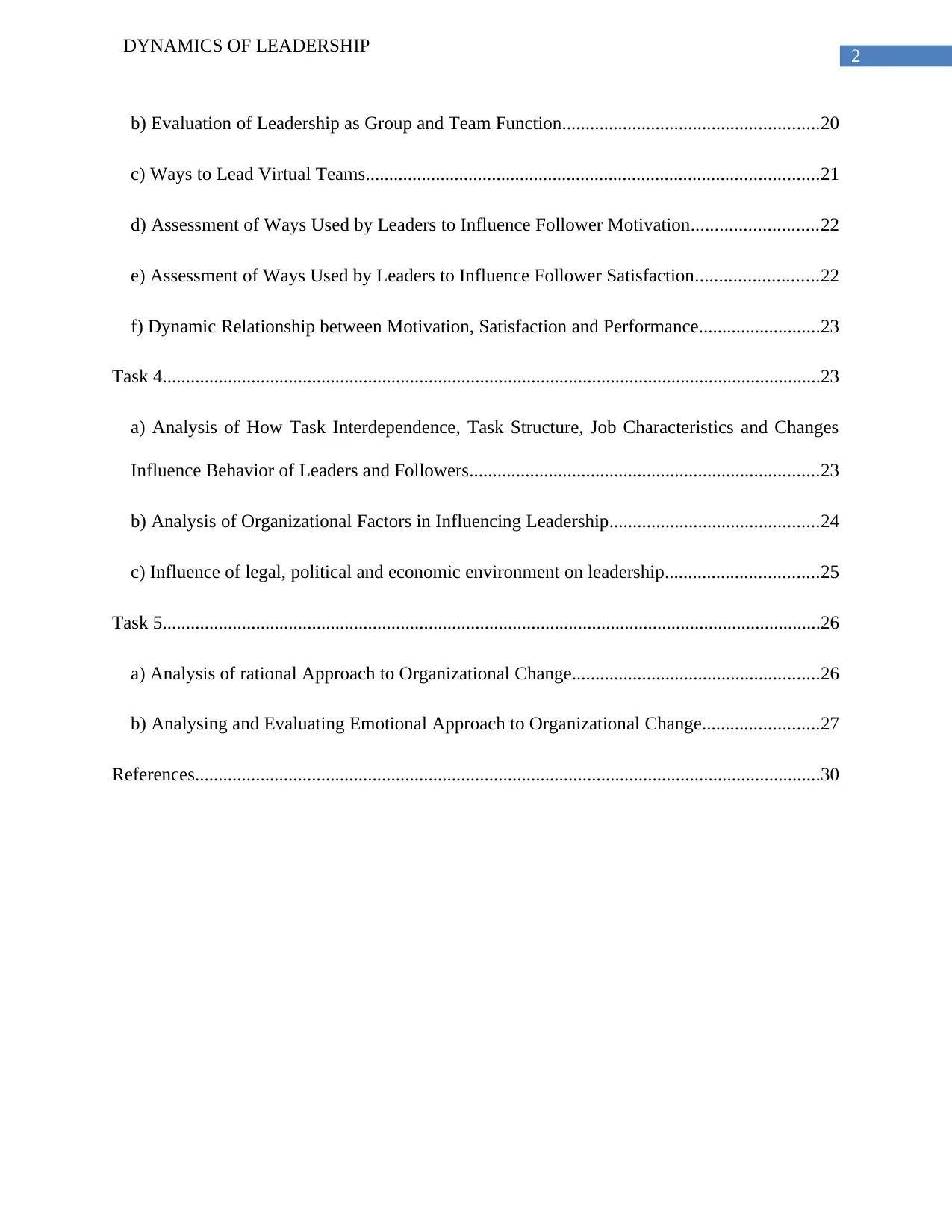
2
DYNAMICS OF LEADERSHIP
b) Evaluation of Leadership as Group and Team Function.......................................................20
c) Ways to Lead Virtual Teams.................................................................................................21
d) Assessment of Ways Used by Leaders to Influence Follower Motivation...........................22
e) Assessment of Ways Used by Leaders to Influence Follower Satisfaction..........................22
f) Dynamic Relationship between Motivation, Satisfaction and Performance..........................23
Task 4.............................................................................................................................................23
a) Analysis of How Task Interdependence, Task Structure, Job Characteristics and Changes
Influence Behavior of Leaders and Followers...........................................................................23
b) Analysis of Organizational Factors in Influencing Leadership.............................................24
c) Influence of legal, political and economic environment on leadership.................................25
Task 5.............................................................................................................................................26
a) Analysis of rational Approach to Organizational Change.....................................................26
b) Analysing and Evaluating Emotional Approach to Organizational Change.........................27
References......................................................................................................................................30
DYNAMICS OF LEADERSHIP
b) Evaluation of Leadership as Group and Team Function.......................................................20
c) Ways to Lead Virtual Teams.................................................................................................21
d) Assessment of Ways Used by Leaders to Influence Follower Motivation...........................22
e) Assessment of Ways Used by Leaders to Influence Follower Satisfaction..........................22
f) Dynamic Relationship between Motivation, Satisfaction and Performance..........................23
Task 4.............................................................................................................................................23
a) Analysis of How Task Interdependence, Task Structure, Job Characteristics and Changes
Influence Behavior of Leaders and Followers...........................................................................23
b) Analysis of Organizational Factors in Influencing Leadership.............................................24
c) Influence of legal, political and economic environment on leadership.................................25
Task 5.............................................................................................................................................26
a) Analysis of rational Approach to Organizational Change.....................................................26
b) Analysing and Evaluating Emotional Approach to Organizational Change.........................27
References......................................................................................................................................30
⊘ This is a preview!⊘
Do you want full access?
Subscribe today to unlock all pages.

Trusted by 1+ million students worldwide
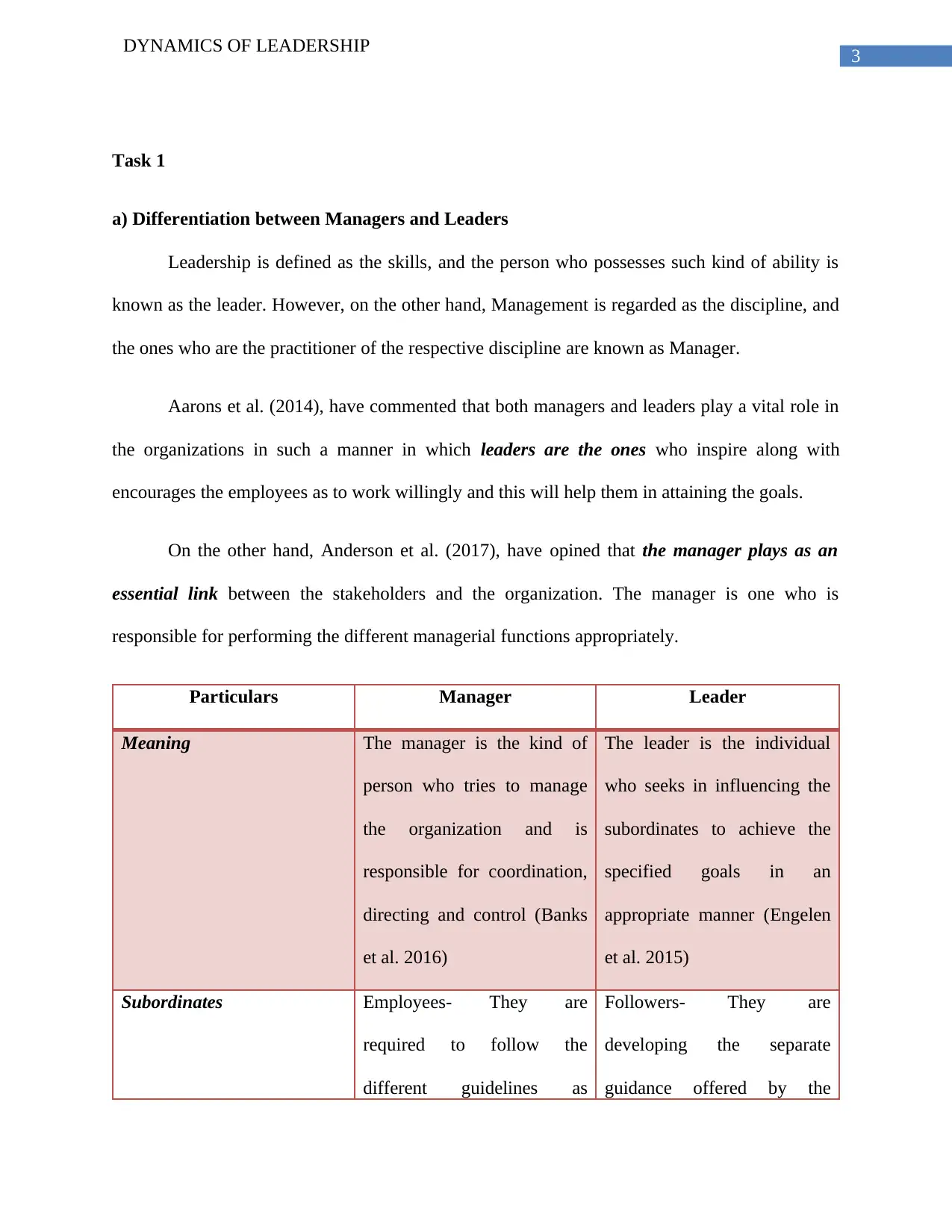
3
DYNAMICS OF LEADERSHIP
Task 1
a) Differentiation between Managers and Leaders
Leadership is defined as the skills, and the person who possesses such kind of ability is
known as the leader. However, on the other hand, Management is regarded as the discipline, and
the ones who are the practitioner of the respective discipline are known as Manager.
Aarons et al. (2014), have commented that both managers and leaders play a vital role in
the organizations in such a manner in which leaders are the ones who inspire along with
encourages the employees as to work willingly and this will help them in attaining the goals.
On the other hand, Anderson et al. (2017), have opined that the manager plays as an
essential link between the stakeholders and the organization. The manager is one who is
responsible for performing the different managerial functions appropriately.
Particulars Manager Leader
Meaning The manager is the kind of
person who tries to manage
the organization and is
responsible for coordination,
directing and control (Banks
et al. 2016)
The leader is the individual
who seeks in influencing the
subordinates to achieve the
specified goals in an
appropriate manner (Engelen
et al. 2015)
Subordinates Employees- They are
required to follow the
different guidelines as
Followers- They are
developing the separate
guidance offered by the
DYNAMICS OF LEADERSHIP
Task 1
a) Differentiation between Managers and Leaders
Leadership is defined as the skills, and the person who possesses such kind of ability is
known as the leader. However, on the other hand, Management is regarded as the discipline, and
the ones who are the practitioner of the respective discipline are known as Manager.
Aarons et al. (2014), have commented that both managers and leaders play a vital role in
the organizations in such a manner in which leaders are the ones who inspire along with
encourages the employees as to work willingly and this will help them in attaining the goals.
On the other hand, Anderson et al. (2017), have opined that the manager plays as an
essential link between the stakeholders and the organization. The manager is one who is
responsible for performing the different managerial functions appropriately.
Particulars Manager Leader
Meaning The manager is the kind of
person who tries to manage
the organization and is
responsible for coordination,
directing and control (Banks
et al. 2016)
The leader is the individual
who seeks in influencing the
subordinates to achieve the
specified goals in an
appropriate manner (Engelen
et al. 2015)
Subordinates Employees- They are
required to follow the
different guidelines as
Followers- They are
developing the separate
guidance offered by the
Paraphrase This Document
Need a fresh take? Get an instant paraphrase of this document with our AI Paraphraser
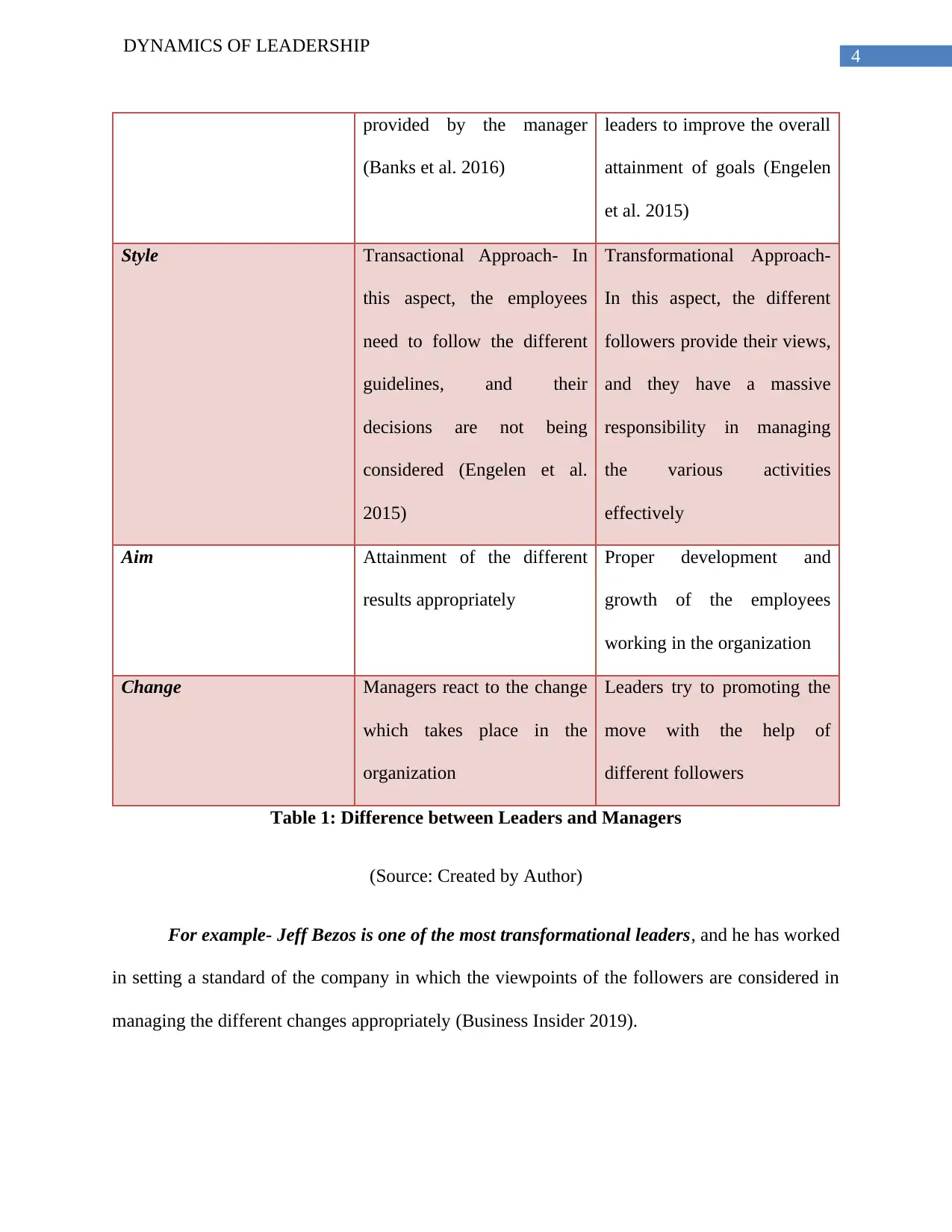
4
DYNAMICS OF LEADERSHIP
provided by the manager
(Banks et al. 2016)
leaders to improve the overall
attainment of goals (Engelen
et al. 2015)
Style Transactional Approach- In
this aspect, the employees
need to follow the different
guidelines, and their
decisions are not being
considered (Engelen et al.
2015)
Transformational Approach-
In this aspect, the different
followers provide their views,
and they have a massive
responsibility in managing
the various activities
effectively
Aim Attainment of the different
results appropriately
Proper development and
growth of the employees
working in the organization
Change Managers react to the change
which takes place in the
organization
Leaders try to promoting the
move with the help of
different followers
Table 1: Difference between Leaders and Managers
(Source: Created by Author)
For example- Jeff Bezos is one of the most transformational leaders, and he has worked
in setting a standard of the company in which the viewpoints of the followers are considered in
managing the different changes appropriately (Business Insider 2019).
DYNAMICS OF LEADERSHIP
provided by the manager
(Banks et al. 2016)
leaders to improve the overall
attainment of goals (Engelen
et al. 2015)
Style Transactional Approach- In
this aspect, the employees
need to follow the different
guidelines, and their
decisions are not being
considered (Engelen et al.
2015)
Transformational Approach-
In this aspect, the different
followers provide their views,
and they have a massive
responsibility in managing
the various activities
effectively
Aim Attainment of the different
results appropriately
Proper development and
growth of the employees
working in the organization
Change Managers react to the change
which takes place in the
organization
Leaders try to promoting the
move with the help of
different followers
Table 1: Difference between Leaders and Managers
(Source: Created by Author)
For example- Jeff Bezos is one of the most transformational leaders, and he has worked
in setting a standard of the company in which the viewpoints of the followers are considered in
managing the different changes appropriately (Business Insider 2019).
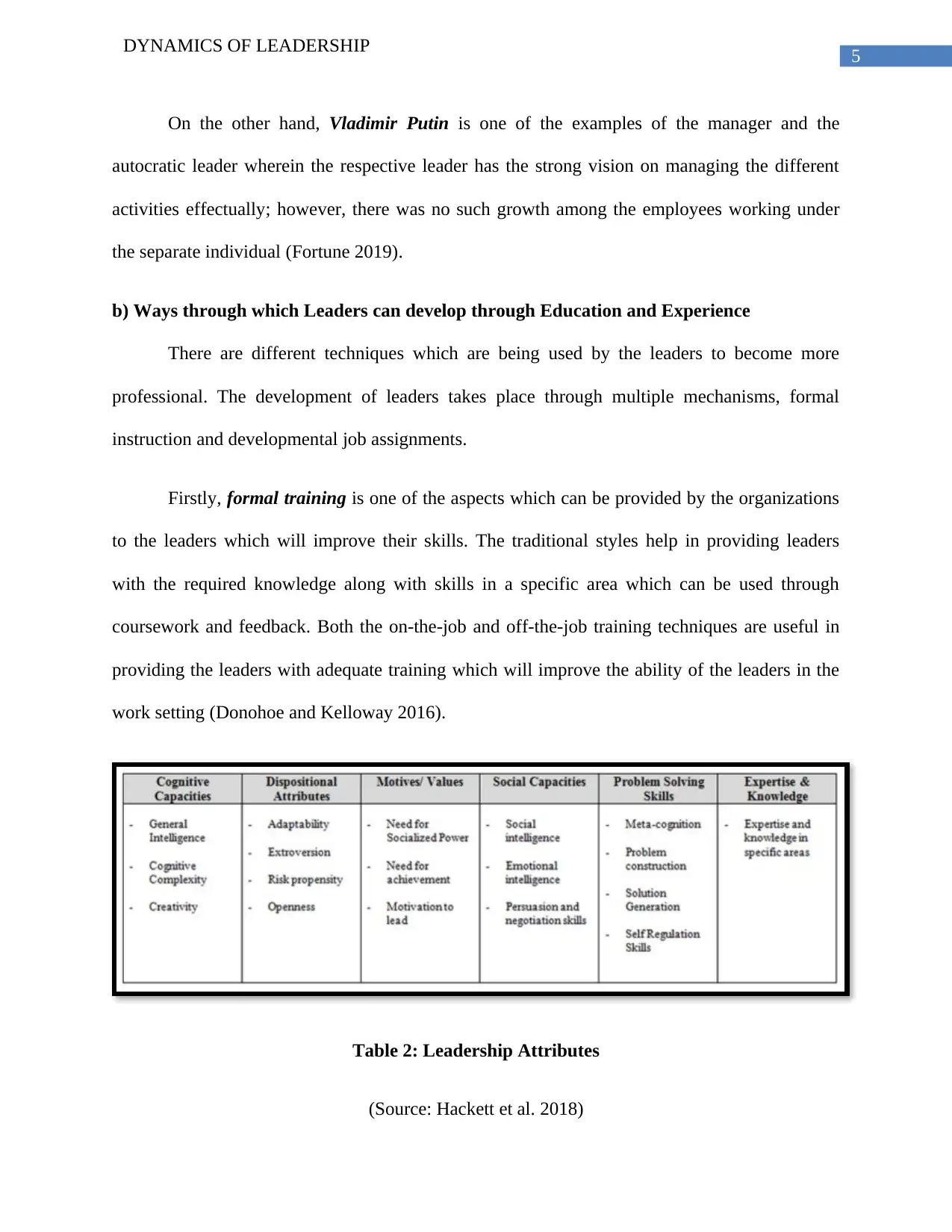
5
DYNAMICS OF LEADERSHIP
On the other hand, Vladimir Putin is one of the examples of the manager and the
autocratic leader wherein the respective leader has the strong vision on managing the different
activities effectually; however, there was no such growth among the employees working under
the separate individual (Fortune 2019).
b) Ways through which Leaders can develop through Education and Experience
There are different techniques which are being used by the leaders to become more
professional. The development of leaders takes place through multiple mechanisms, formal
instruction and developmental job assignments.
Firstly, formal training is one of the aspects which can be provided by the organizations
to the leaders which will improve their skills. The traditional styles help in providing leaders
with the required knowledge along with skills in a specific area which can be used through
coursework and feedback. Both the on-the-job and off-the-job training techniques are useful in
providing the leaders with adequate training which will improve the ability of the leaders in the
work setting (Donohoe and Kelloway 2016).
Table 2: Leadership Attributes
(Source: Hackett et al. 2018)
DYNAMICS OF LEADERSHIP
On the other hand, Vladimir Putin is one of the examples of the manager and the
autocratic leader wherein the respective leader has the strong vision on managing the different
activities effectually; however, there was no such growth among the employees working under
the separate individual (Fortune 2019).
b) Ways through which Leaders can develop through Education and Experience
There are different techniques which are being used by the leaders to become more
professional. The development of leaders takes place through multiple mechanisms, formal
instruction and developmental job assignments.
Firstly, formal training is one of the aspects which can be provided by the organizations
to the leaders which will improve their skills. The traditional styles help in providing leaders
with the required knowledge along with skills in a specific area which can be used through
coursework and feedback. Both the on-the-job and off-the-job training techniques are useful in
providing the leaders with adequate training which will improve the ability of the leaders in the
work setting (Donohoe and Kelloway 2016).
Table 2: Leadership Attributes
(Source: Hackett et al. 2018)
⊘ This is a preview!⊘
Do you want full access?
Subscribe today to unlock all pages.

Trusted by 1+ million students worldwide
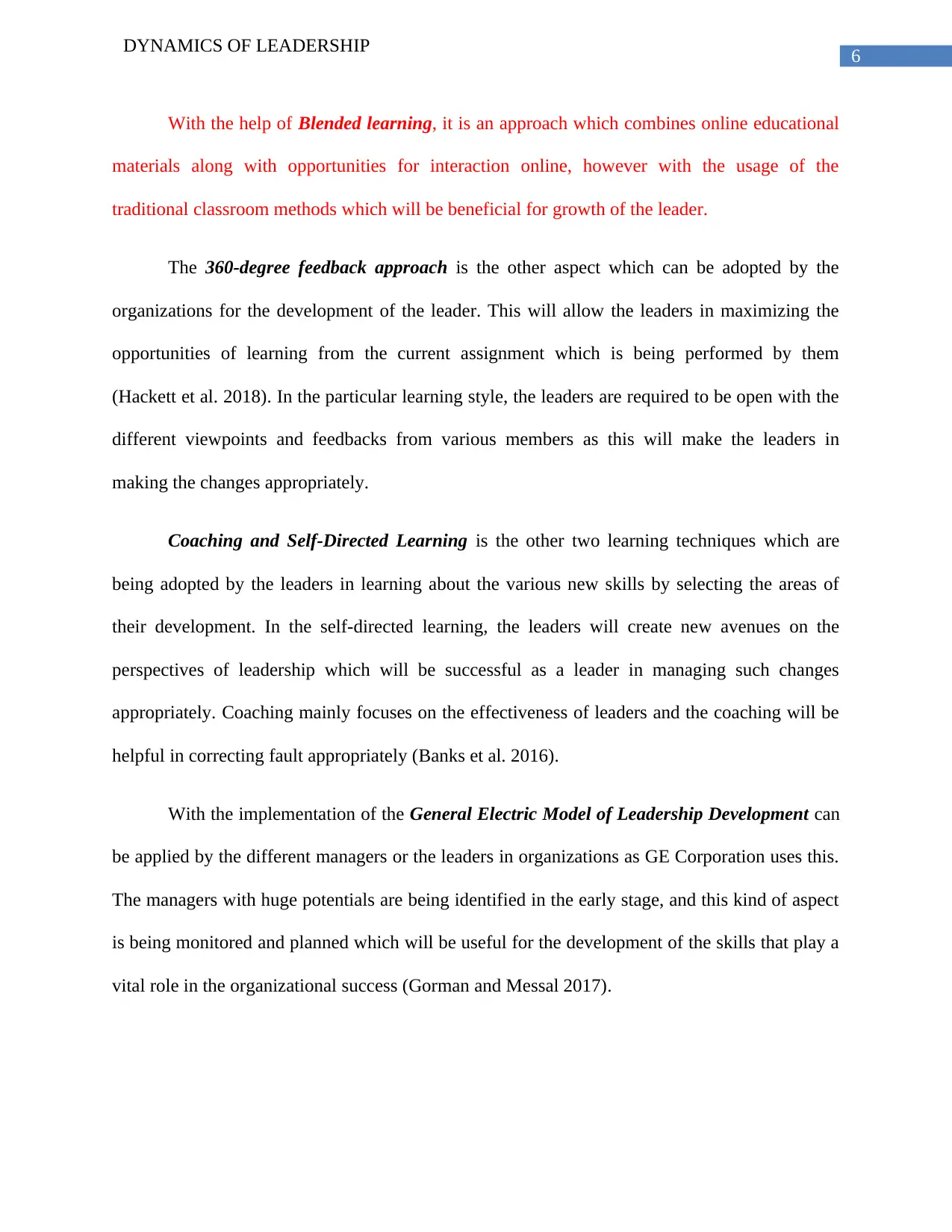
6
DYNAMICS OF LEADERSHIP
With the help of Blended learning, it is an approach which combines online educational
materials along with opportunities for interaction online, however with the usage of the
traditional classroom methods which will be beneficial for growth of the leader.
The 360-degree feedback approach is the other aspect which can be adopted by the
organizations for the development of the leader. This will allow the leaders in maximizing the
opportunities of learning from the current assignment which is being performed by them
(Hackett et al. 2018). In the particular learning style, the leaders are required to be open with the
different viewpoints and feedbacks from various members as this will make the leaders in
making the changes appropriately.
Coaching and Self-Directed Learning is the other two learning techniques which are
being adopted by the leaders in learning about the various new skills by selecting the areas of
their development. In the self-directed learning, the leaders will create new avenues on the
perspectives of leadership which will be successful as a leader in managing such changes
appropriately. Coaching mainly focuses on the effectiveness of leaders and the coaching will be
helpful in correcting fault appropriately (Banks et al. 2016).
With the implementation of the General Electric Model of Leadership Development can
be applied by the different managers or the leaders in organizations as GE Corporation uses this.
The managers with huge potentials are being identified in the early stage, and this kind of aspect
is being monitored and planned which will be useful for the development of the skills that play a
vital role in the organizational success (Gorman and Messal 2017).
DYNAMICS OF LEADERSHIP
With the help of Blended learning, it is an approach which combines online educational
materials along with opportunities for interaction online, however with the usage of the
traditional classroom methods which will be beneficial for growth of the leader.
The 360-degree feedback approach is the other aspect which can be adopted by the
organizations for the development of the leader. This will allow the leaders in maximizing the
opportunities of learning from the current assignment which is being performed by them
(Hackett et al. 2018). In the particular learning style, the leaders are required to be open with the
different viewpoints and feedbacks from various members as this will make the leaders in
making the changes appropriately.
Coaching and Self-Directed Learning is the other two learning techniques which are
being adopted by the leaders in learning about the various new skills by selecting the areas of
their development. In the self-directed learning, the leaders will create new avenues on the
perspectives of leadership which will be successful as a leader in managing such changes
appropriately. Coaching mainly focuses on the effectiveness of leaders and the coaching will be
helpful in correcting fault appropriately (Banks et al. 2016).
With the implementation of the General Electric Model of Leadership Development can
be applied by the different managers or the leaders in organizations as GE Corporation uses this.
The managers with huge potentials are being identified in the early stage, and this kind of aspect
is being monitored and planned which will be useful for the development of the skills that play a
vital role in the organizational success (Gorman and Messal 2017).
Paraphrase This Document
Need a fresh take? Get an instant paraphrase of this document with our AI Paraphraser
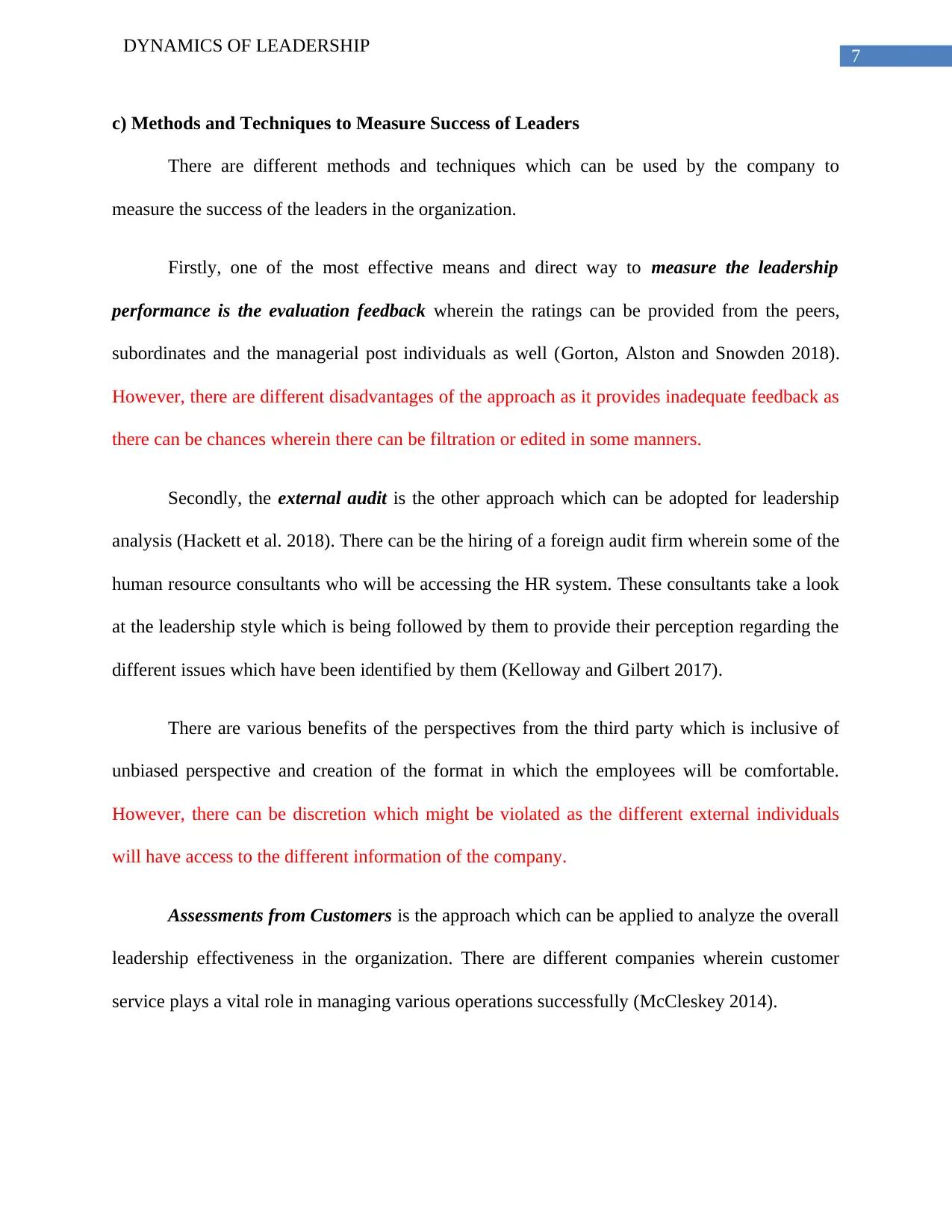
7
DYNAMICS OF LEADERSHIP
c) Methods and Techniques to Measure Success of Leaders
There are different methods and techniques which can be used by the company to
measure the success of the leaders in the organization.
Firstly, one of the most effective means and direct way to measure the leadership
performance is the evaluation feedback wherein the ratings can be provided from the peers,
subordinates and the managerial post individuals as well (Gorton, Alston and Snowden 2018).
However, there are different disadvantages of the approach as it provides inadequate feedback as
there can be chances wherein there can be filtration or edited in some manners.
Secondly, the external audit is the other approach which can be adopted for leadership
analysis (Hackett et al. 2018). There can be the hiring of a foreign audit firm wherein some of the
human resource consultants who will be accessing the HR system. These consultants take a look
at the leadership style which is being followed by them to provide their perception regarding the
different issues which have been identified by them (Kelloway and Gilbert 2017).
There are various benefits of the perspectives from the third party which is inclusive of
unbiased perspective and creation of the format in which the employees will be comfortable.
However, there can be discretion which might be violated as the different external individuals
will have access to the different information of the company.
Assessments from Customers is the approach which can be applied to analyze the overall
leadership effectiveness in the organization. There are different companies wherein customer
service plays a vital role in managing various operations successfully (McCleskey 2014).
DYNAMICS OF LEADERSHIP
c) Methods and Techniques to Measure Success of Leaders
There are different methods and techniques which can be used by the company to
measure the success of the leaders in the organization.
Firstly, one of the most effective means and direct way to measure the leadership
performance is the evaluation feedback wherein the ratings can be provided from the peers,
subordinates and the managerial post individuals as well (Gorton, Alston and Snowden 2018).
However, there are different disadvantages of the approach as it provides inadequate feedback as
there can be chances wherein there can be filtration or edited in some manners.
Secondly, the external audit is the other approach which can be adopted for leadership
analysis (Hackett et al. 2018). There can be the hiring of a foreign audit firm wherein some of the
human resource consultants who will be accessing the HR system. These consultants take a look
at the leadership style which is being followed by them to provide their perception regarding the
different issues which have been identified by them (Kelloway and Gilbert 2017).
There are various benefits of the perspectives from the third party which is inclusive of
unbiased perspective and creation of the format in which the employees will be comfortable.
However, there can be discretion which might be violated as the different external individuals
will have access to the different information of the company.
Assessments from Customers is the approach which can be applied to analyze the overall
leadership effectiveness in the organization. There are different companies wherein customer
service plays a vital role in managing various operations successfully (McCleskey 2014).
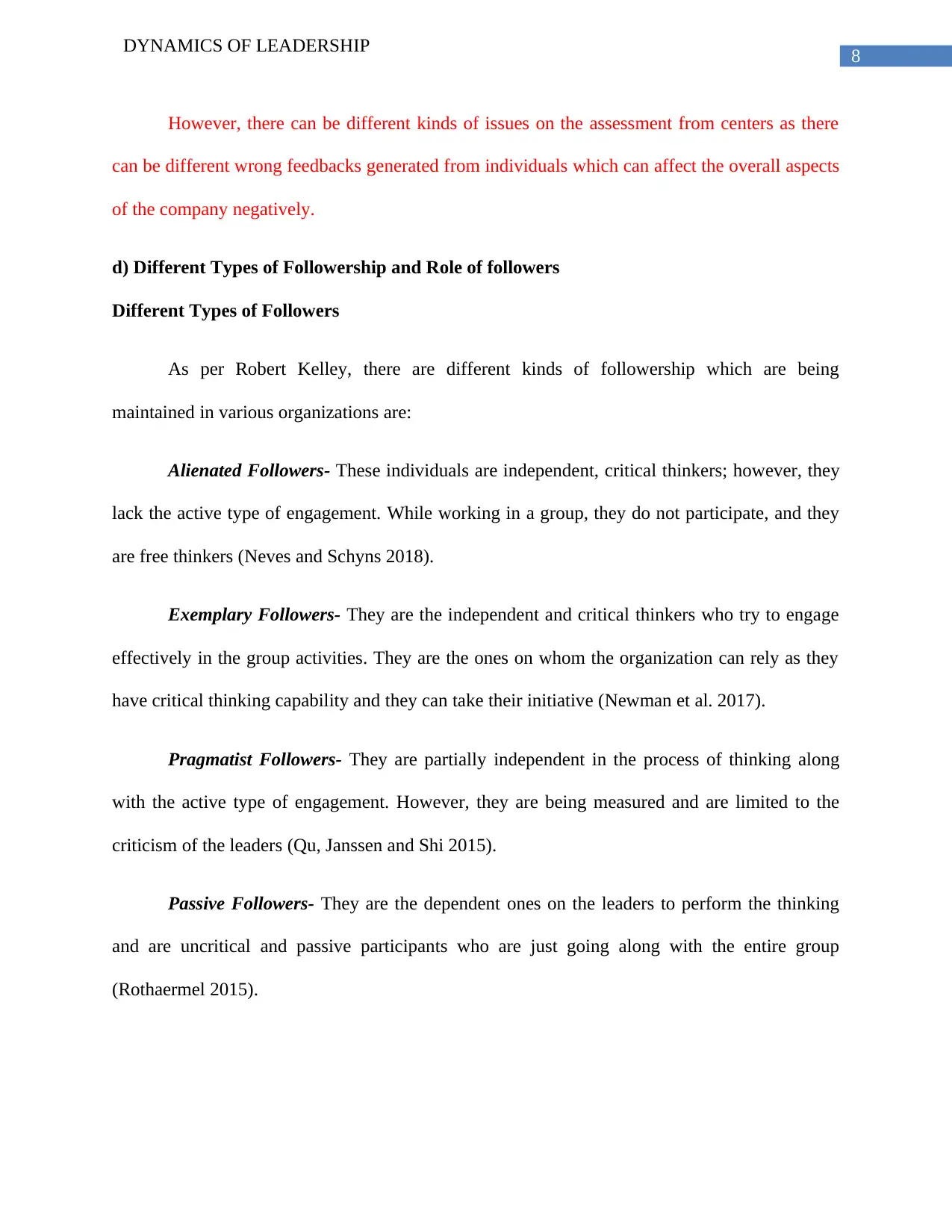
8
DYNAMICS OF LEADERSHIP
However, there can be different kinds of issues on the assessment from centers as there
can be different wrong feedbacks generated from individuals which can affect the overall aspects
of the company negatively.
d) Different Types of Followership and Role of followers
Different Types of Followers
As per Robert Kelley, there are different kinds of followership which are being
maintained in various organizations are:
Alienated Followers- These individuals are independent, critical thinkers; however, they
lack the active type of engagement. While working in a group, they do not participate, and they
are free thinkers (Neves and Schyns 2018).
Exemplary Followers- They are the independent and critical thinkers who try to engage
effectively in the group activities. They are the ones on whom the organization can rely as they
have critical thinking capability and they can take their initiative (Newman et al. 2017).
Pragmatist Followers- They are partially independent in the process of thinking along
with the active type of engagement. However, they are being measured and are limited to the
criticism of the leaders (Qu, Janssen and Shi 2015).
Passive Followers- They are the dependent ones on the leaders to perform the thinking
and are uncritical and passive participants who are just going along with the entire group
(Rothaermel 2015).
DYNAMICS OF LEADERSHIP
However, there can be different kinds of issues on the assessment from centers as there
can be different wrong feedbacks generated from individuals which can affect the overall aspects
of the company negatively.
d) Different Types of Followership and Role of followers
Different Types of Followers
As per Robert Kelley, there are different kinds of followership which are being
maintained in various organizations are:
Alienated Followers- These individuals are independent, critical thinkers; however, they
lack the active type of engagement. While working in a group, they do not participate, and they
are free thinkers (Neves and Schyns 2018).
Exemplary Followers- They are the independent and critical thinkers who try to engage
effectively in the group activities. They are the ones on whom the organization can rely as they
have critical thinking capability and they can take their initiative (Newman et al. 2017).
Pragmatist Followers- They are partially independent in the process of thinking along
with the active type of engagement. However, they are being measured and are limited to the
criticism of the leaders (Qu, Janssen and Shi 2015).
Passive Followers- They are the dependent ones on the leaders to perform the thinking
and are uncritical and passive participants who are just going along with the entire group
(Rothaermel 2015).
⊘ This is a preview!⊘
Do you want full access?
Subscribe today to unlock all pages.

Trusted by 1+ million students worldwide
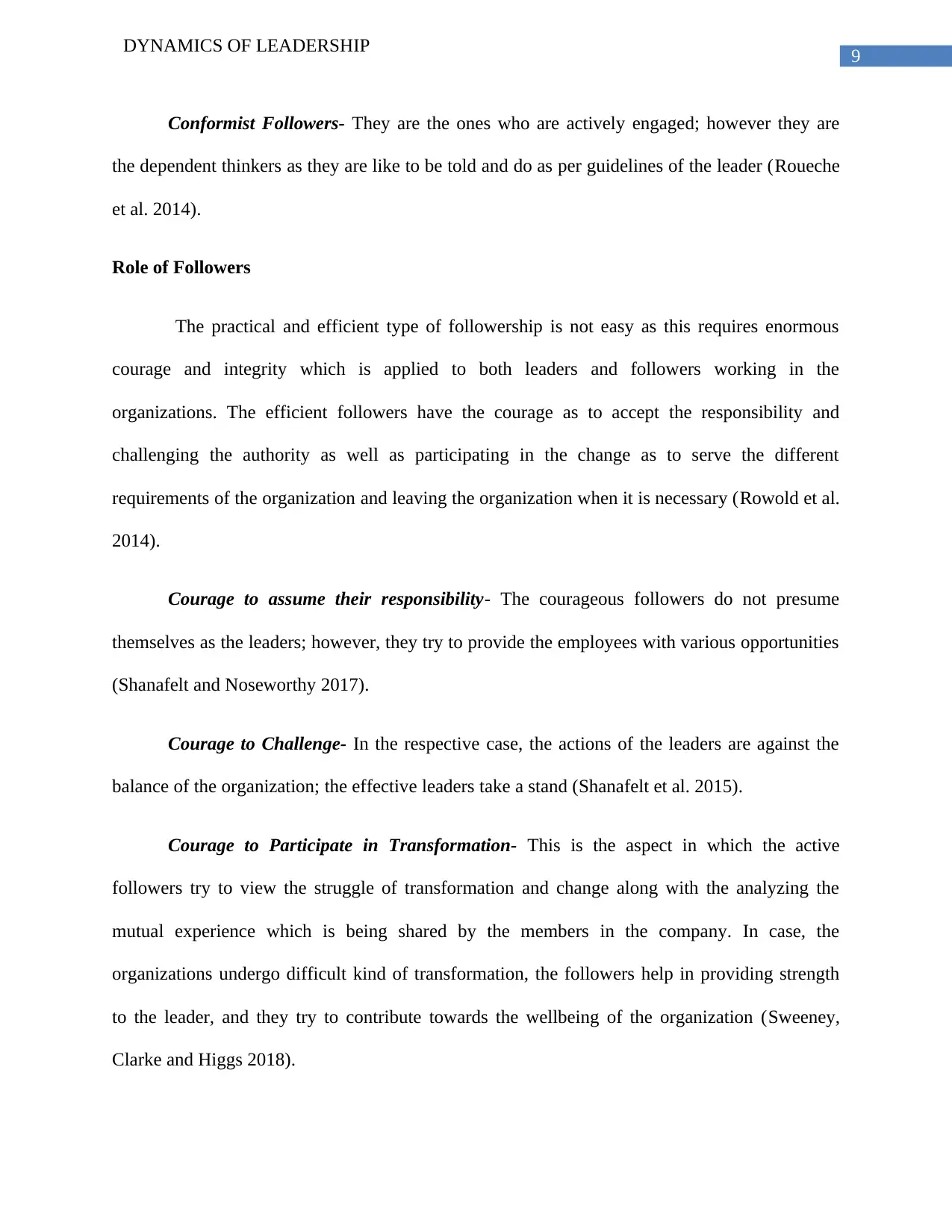
9
DYNAMICS OF LEADERSHIP
Conformist Followers- They are the ones who are actively engaged; however they are
the dependent thinkers as they are like to be told and do as per guidelines of the leader (Roueche
et al. 2014).
Role of Followers
The practical and efficient type of followership is not easy as this requires enormous
courage and integrity which is applied to both leaders and followers working in the
organizations. The efficient followers have the courage as to accept the responsibility and
challenging the authority as well as participating in the change as to serve the different
requirements of the organization and leaving the organization when it is necessary (Rowold et al.
2014).
Courage to assume their responsibility- The courageous followers do not presume
themselves as the leaders; however, they try to provide the employees with various opportunities
(Shanafelt and Noseworthy 2017).
Courage to Challenge- In the respective case, the actions of the leaders are against the
balance of the organization; the effective leaders take a stand (Shanafelt et al. 2015).
Courage to Participate in Transformation- This is the aspect in which the active
followers try to view the struggle of transformation and change along with the analyzing the
mutual experience which is being shared by the members in the company. In case, the
organizations undergo difficult kind of transformation, the followers help in providing strength
to the leader, and they try to contribute towards the wellbeing of the organization (Sweeney,
Clarke and Higgs 2018).
DYNAMICS OF LEADERSHIP
Conformist Followers- They are the ones who are actively engaged; however they are
the dependent thinkers as they are like to be told and do as per guidelines of the leader (Roueche
et al. 2014).
Role of Followers
The practical and efficient type of followership is not easy as this requires enormous
courage and integrity which is applied to both leaders and followers working in the
organizations. The efficient followers have the courage as to accept the responsibility and
challenging the authority as well as participating in the change as to serve the different
requirements of the organization and leaving the organization when it is necessary (Rowold et al.
2014).
Courage to assume their responsibility- The courageous followers do not presume
themselves as the leaders; however, they try to provide the employees with various opportunities
(Shanafelt and Noseworthy 2017).
Courage to Challenge- In the respective case, the actions of the leaders are against the
balance of the organization; the effective leaders take a stand (Shanafelt et al. 2015).
Courage to Participate in Transformation- This is the aspect in which the active
followers try to view the struggle of transformation and change along with the analyzing the
mutual experience which is being shared by the members in the company. In case, the
organizations undergo difficult kind of transformation, the followers help in providing strength
to the leader, and they try to contribute towards the wellbeing of the organization (Sweeney,
Clarke and Higgs 2018).
Paraphrase This Document
Need a fresh take? Get an instant paraphrase of this document with our AI Paraphraser
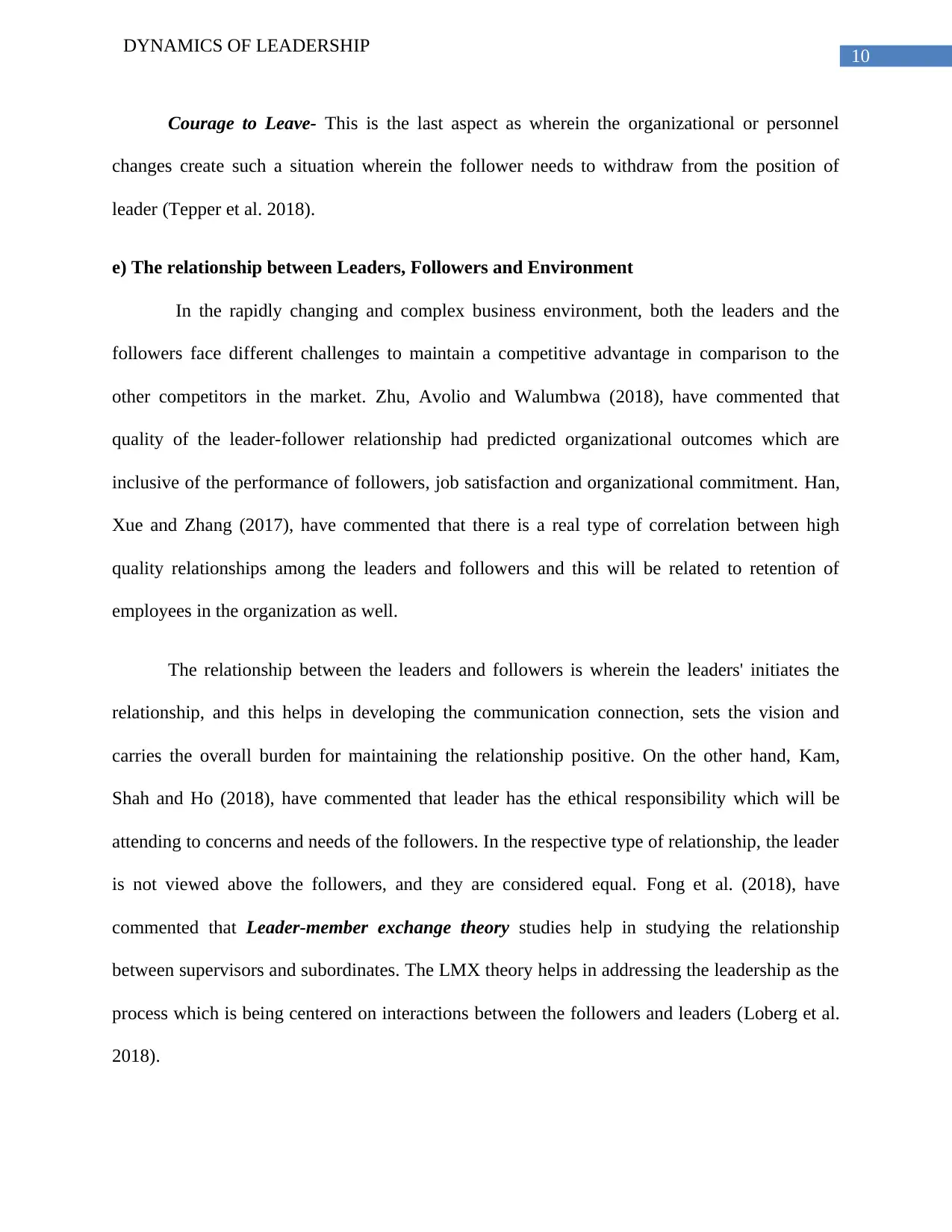
10
DYNAMICS OF LEADERSHIP
Courage to Leave- This is the last aspect as wherein the organizational or personnel
changes create such a situation wherein the follower needs to withdraw from the position of
leader (Tepper et al. 2018).
e) The relationship between Leaders, Followers and Environment
In the rapidly changing and complex business environment, both the leaders and the
followers face different challenges to maintain a competitive advantage in comparison to the
other competitors in the market. Zhu, Avolio and Walumbwa (2018), have commented that
quality of the leader-follower relationship had predicted organizational outcomes which are
inclusive of the performance of followers, job satisfaction and organizational commitment. Han,
Xue and Zhang (2017), have commented that there is a real type of correlation between high
quality relationships among the leaders and followers and this will be related to retention of
employees in the organization as well.
The relationship between the leaders and followers is wherein the leaders' initiates the
relationship, and this helps in developing the communication connection, sets the vision and
carries the overall burden for maintaining the relationship positive. On the other hand, Kam,
Shah and Ho (2018), have commented that leader has the ethical responsibility which will be
attending to concerns and needs of the followers. In the respective type of relationship, the leader
is not viewed above the followers, and they are considered equal. Fong et al. (2018), have
commented that Leader-member exchange theory studies help in studying the relationship
between supervisors and subordinates. The LMX theory helps in addressing the leadership as the
process which is being centered on interactions between the followers and leaders (Loberg et al.
2018).
DYNAMICS OF LEADERSHIP
Courage to Leave- This is the last aspect as wherein the organizational or personnel
changes create such a situation wherein the follower needs to withdraw from the position of
leader (Tepper et al. 2018).
e) The relationship between Leaders, Followers and Environment
In the rapidly changing and complex business environment, both the leaders and the
followers face different challenges to maintain a competitive advantage in comparison to the
other competitors in the market. Zhu, Avolio and Walumbwa (2018), have commented that
quality of the leader-follower relationship had predicted organizational outcomes which are
inclusive of the performance of followers, job satisfaction and organizational commitment. Han,
Xue and Zhang (2017), have commented that there is a real type of correlation between high
quality relationships among the leaders and followers and this will be related to retention of
employees in the organization as well.
The relationship between the leaders and followers is wherein the leaders' initiates the
relationship, and this helps in developing the communication connection, sets the vision and
carries the overall burden for maintaining the relationship positive. On the other hand, Kam,
Shah and Ho (2018), have commented that leader has the ethical responsibility which will be
attending to concerns and needs of the followers. In the respective type of relationship, the leader
is not viewed above the followers, and they are considered equal. Fong et al. (2018), have
commented that Leader-member exchange theory studies help in studying the relationship
between supervisors and subordinates. The LMX theory helps in addressing the leadership as the
process which is being centered on interactions between the followers and leaders (Loberg et al.
2018).
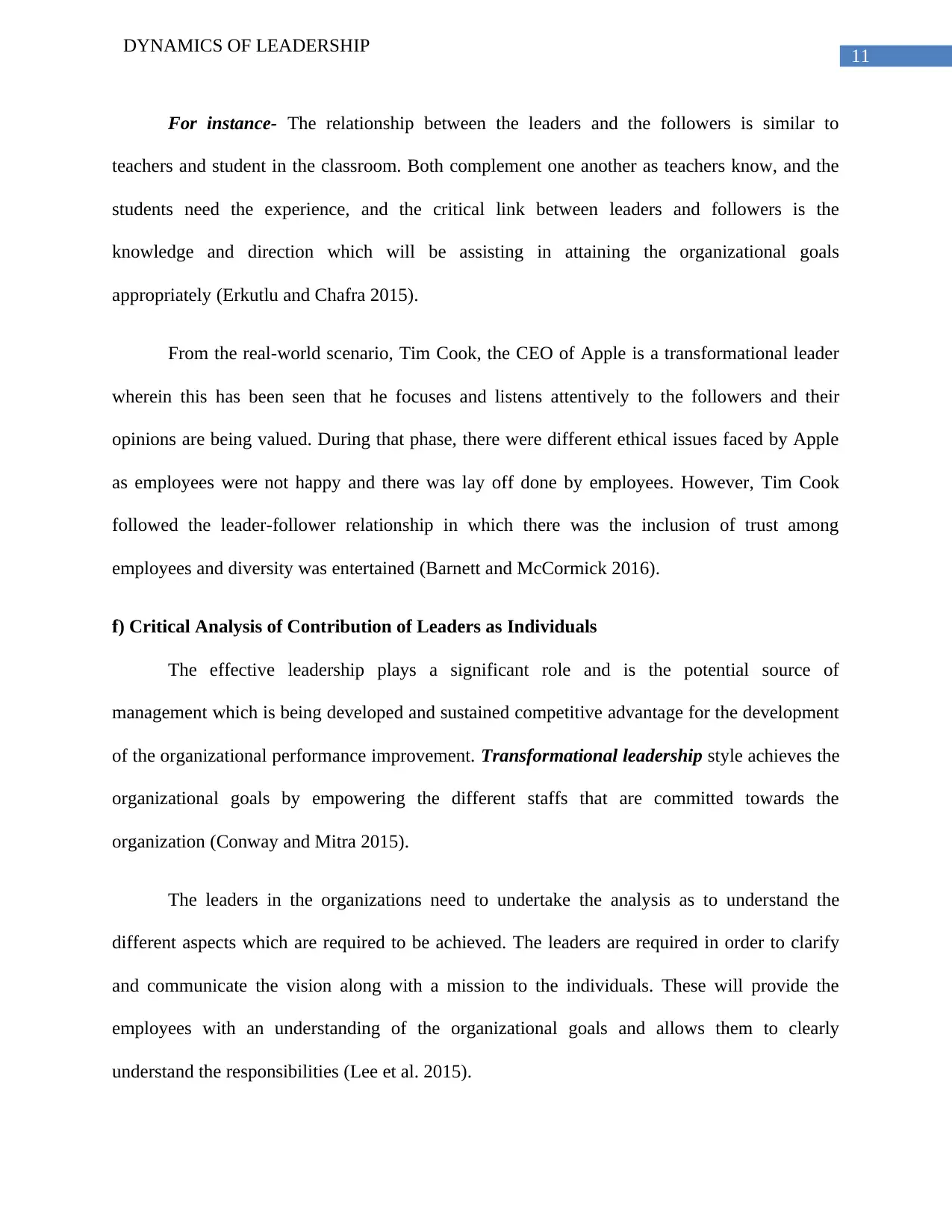
11
DYNAMICS OF LEADERSHIP
For instance- The relationship between the leaders and the followers is similar to
teachers and student in the classroom. Both complement one another as teachers know, and the
students need the experience, and the critical link between leaders and followers is the
knowledge and direction which will be assisting in attaining the organizational goals
appropriately (Erkutlu and Chafra 2015).
From the real-world scenario, Tim Cook, the CEO of Apple is a transformational leader
wherein this has been seen that he focuses and listens attentively to the followers and their
opinions are being valued. During that phase, there were different ethical issues faced by Apple
as employees were not happy and there was lay off done by employees. However, Tim Cook
followed the leader-follower relationship in which there was the inclusion of trust among
employees and diversity was entertained (Barnett and McCormick 2016).
f) Critical Analysis of Contribution of Leaders as Individuals
The effective leadership plays a significant role and is the potential source of
management which is being developed and sustained competitive advantage for the development
of the organizational performance improvement. Transformational leadership style achieves the
organizational goals by empowering the different staffs that are committed towards the
organization (Conway and Mitra 2015).
The leaders in the organizations need to undertake the analysis as to understand the
different aspects which are required to be achieved. The leaders are required in order to clarify
and communicate the vision along with a mission to the individuals. These will provide the
employees with an understanding of the organizational goals and allows them to clearly
understand the responsibilities (Lee et al. 2015).
DYNAMICS OF LEADERSHIP
For instance- The relationship between the leaders and the followers is similar to
teachers and student in the classroom. Both complement one another as teachers know, and the
students need the experience, and the critical link between leaders and followers is the
knowledge and direction which will be assisting in attaining the organizational goals
appropriately (Erkutlu and Chafra 2015).
From the real-world scenario, Tim Cook, the CEO of Apple is a transformational leader
wherein this has been seen that he focuses and listens attentively to the followers and their
opinions are being valued. During that phase, there were different ethical issues faced by Apple
as employees were not happy and there was lay off done by employees. However, Tim Cook
followed the leader-follower relationship in which there was the inclusion of trust among
employees and diversity was entertained (Barnett and McCormick 2016).
f) Critical Analysis of Contribution of Leaders as Individuals
The effective leadership plays a significant role and is the potential source of
management which is being developed and sustained competitive advantage for the development
of the organizational performance improvement. Transformational leadership style achieves the
organizational goals by empowering the different staffs that are committed towards the
organization (Conway and Mitra 2015).
The leaders in the organizations need to undertake the analysis as to understand the
different aspects which are required to be achieved. The leaders are required in order to clarify
and communicate the vision along with a mission to the individuals. These will provide the
employees with an understanding of the organizational goals and allows them to clearly
understand the responsibilities (Lee et al. 2015).
⊘ This is a preview!⊘
Do you want full access?
Subscribe today to unlock all pages.

Trusted by 1+ million students worldwide
1 out of 43
Related Documents
Your All-in-One AI-Powered Toolkit for Academic Success.
+13062052269
info@desklib.com
Available 24*7 on WhatsApp / Email
![[object Object]](/_next/static/media/star-bottom.7253800d.svg)
Unlock your academic potential
Copyright © 2020–2025 A2Z Services. All Rights Reserved. Developed and managed by ZUCOL.





